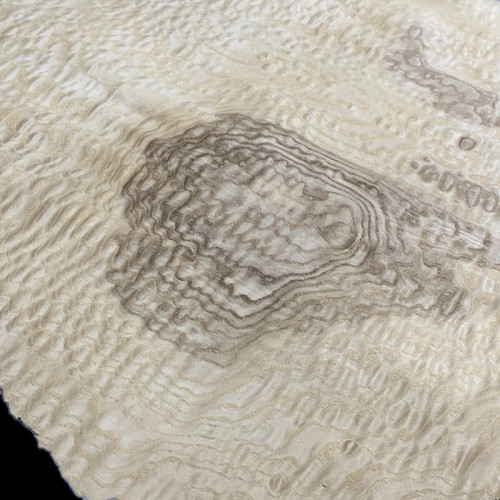
Pommele Ash Veneers 90x 40 cm
Pommele Ash Veneers 90x 40 cm
Genuine wood sliced-veneer sheets.
Length: 90 cm.
Width: 40 cm.
Thickness: 0.55 mm.
Sold by the sheet.
Pictures herewith are photos of the product you will receive.
Pommele Ash Veneers 90x 40 cm
Genuine wood sliced-veneer sheets.
This veneer is a European "White" Ash with a brown heart, and not a gray Ash as Tamo is generally.
Dimensions:
Length: 90 cm.
Width: 40 cm.
Thickness: 0.55 mm.
Measurement scaling:
Dimensions are measured at the small end.
- Width rounded to the covered centimeter: 15.8, giving 15 cm.
- Length rounded to 5 centimeters: 257, giving 255 cm.
Species:
Common name: Tamo, Pommele Ash.
Botanical name: Fraxinus excelsior.
Origin: Europe.
Tamo is distinguished by its pommele grain, a very aesthetic rarity.
Tamo is a Japanese name meaning "tree of wisdom". It refers to a Pommele Ash.
Tamo is generally a Gray Ash, typically found from the Ural Mountains to Japan.
In Japan, around 1920, Tamo was first used as a sliced veneer to cover the face of getas (traditional Japanese clogs).
It has been imported into Europe since the end of the 19th century. It has been used for Art Deco furniture.
Popularized in the West for manufacturing high-end furniture between 1930 and 1950, it has since been highly sought after for decorative purposes and electric guitar construction.
But here, this veneer is a European "White" Ash with a brown heart. It has a very marked pommele character.
From a historical point of view, this Pommele Ash was used on 17th-century German furniture. It was from Hungary.
Product Description:
Genuine wood-sliced veneer sheets.
These veneers are raw without a finish or any fleece back.
The veneer surface is similar to plane wood. However, it will be preferable to forecast a light sanding after gluing.
The veneers are offered here as wood-sliced sheets of one and unique thickness.
Both faces of these veneers are the same, without fleece back or glue.
Even if the veneer's sides had been cut relatively straight, it isn't a precise parallel clipping; some veneers may have kept the decreasing shape of the tree, wider at the bottom end and narrower at the top end.
Very occasionally, some veneer's sides have traces of unclipped wane, but our veneers are measured at the narrowest, as explained in the paragraph "Dimensions."
As genuine natural wood, all finishing products are acceptable as long these products are meant to be used for wood.
The choice of the finished product must be consistent with the final usage realization.
Pictures:
Pictures herewith are actual photos of the product you will receive.
For presentation, the veneer sheets may have been juxtaposed to give you a better idea of the final aspect after splicing; this is only a suggestion; display it as you wish.
Utilization:
Cutting:
Veneers can be easily cut with a utility knife.
For straight cuts, the best results are obtained with a veneer saw.
Use a fretsaw, scalpel, or veneer knife for curved cuts.
Always allow for a slightly larger veneer sheet than your intended surface. This will allow you to adjust the size after gluing for a clean finish.
A flush trimmer can also be used to trim the veneer after gluing.
When cutting with a utility knife or veneer knife, it is best to cut with the grain of the wood. To check this, run your finger along the edge of the sheet. The direction that feels smoothest is the ideal direction for cutting.
Gluing:
Several types of gluing are possible.
With vinylic glue, the veneer is pressed over its entire surface.
With neoprene glue, apply two coats of glue and marouflage for all surfaces, especially non-porous surfaces.
With animal glue such as hide, sinew, or bone glue.
With vinyl glue and an iron, apply two thin coats of glue to each piece. This technique should only be used if other gluing techniques are not possible.
Sanding:
Veneers and all our products are genuine wood and can be sanded according to thickness.
Regardless of the thickness of the veneer, please do not use a belt sander, as this could pierce it.
With a 0.6 mm veneer, lightly sand with 120 grit and then finish with 180 or 240 grit. With an orbital sander, 180 grit is already sufficient for most applications.
Finishing:
All finishing products generally used for wood are suitable for finishing our products. For example, you can use a varnish, wax, paint, or oil.
However, ensure that the product you want to use is compatible with the final use of your creation.
Look at our TUTORIALS, and you might find some valuable tips.
Packing:
Veneers are rolled and well protected in a strong cardboard box chosen for resisting somewhat vigorous handling and delivered to you in good condition.
Prices:
Sold by the sheet, decreasing prices upon quantity.
More info:
Should you need more info, please get in touch with us either by e-mail or by telephone.
Look at our TUTORIALS, and you might find some valuable tips.
Data sheet
- Species
- Tamo
- Thickness group
- Standard
- Width group
- XXL width
- Grade
- Pommele
 English
English





